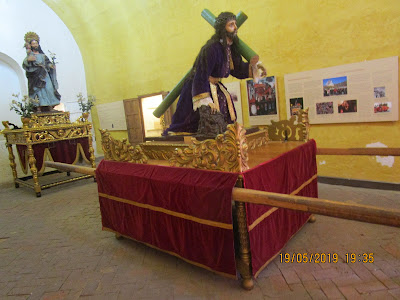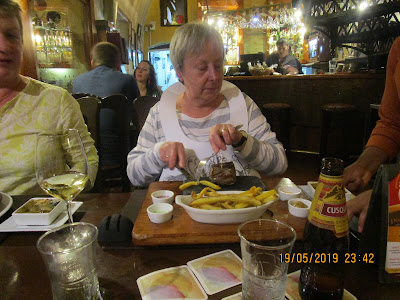There was a procession starting from this church.
Henry striding out with his "family"close behind!
Henry stopped with this street vendor for us to taste her ice-cream. It was very cinnamony. Most people bought one.
Arequipa is also known as the white city because of the number of buildings built from sillar, a porous rock collected from the neighbouring volcanoes. Legend has it that the 4th Inca ruler, Mayta Capac, was so captivated by the climate and location of present-day Arequipa that he stopped and exclaimed "Ari quepay" in Quechua, meaning "Yes, stay".
I suspect we were not in top form!
We made a bit more of an effort here!
We had planned to go to the museum where the frozen mummy Juanita is but the tour would take an hour and we wanted to go to the Santa Catalina Monastery. Mummy Juanita is housed in the Museo Santuarios Andinos in Arequipa. She was discovered in 1995 on the top of Mount Ampato, a dormant volcano in the Peruvian Andes and is the mummy of a 15th century Incan girl. Her body was preserved due to the frigid conditions on the top of the mountain and was discovered by archaeologists when Mount Ampato's ice cap melted due to volcanic action in a nearby mountain. Scientists believe that Juanita was between 12 and 15 when she died and that she was a human sacrifice to appease the gods or to prevent a natural disaster. Henry told us all about the rites of the Incas that involved the sacrifice of the healthiest members of their society. It was a shame we couldn't get to the museum.
We stopped for a drink - beer for Jim and Sarah, a pina colada for Charlotte and a pina colada sin alcohol for me. Then we set off for our tour of the monastery with an English speaking guide. It was a whistlestop tour but, I suppose, we could always go back round again if we wanted. Santa Catalina Monastery was founded in 1580 by a rich widow, Dona Maria de Guzman. It served as a cloister for Dominican nuns from the 16th to the 18th centuries and there is still a small religious community there.
From here you go under the Silencio arch into the novice cloister marked by a rubber tree in its centre. Novice nuns took a vow of silence and resolved themselves to a life of work and prayer. They lived as novices for 4 years during which time their wealthy families were expected to pay a dowry of 100 gold coins a year.
Life size depiction of the Last Supper.
Wall paintings.
Graduated novices passed into the Orange Cloister, named for the orange trees in its centre that represent renewal and eternal life.
This is the Profundis room, a mortuary where dead nuns were mourned. Paintings of the deceased line the walls
The three crosses set among the orange trees in the Orange Cloister are the centre of the Passion of Christ ceremonies when the monastery is closed to visitors.
Toledo street is flanked by cells in which were the living quarters of the nuns. These would house one or more nuns and some servants. They range from austere to lavish depending on the wealth of the inhabitants.
This is the laundry area filled with big earthen storage vats.
The Spanish architecture of Santa Catalina is characterised by tiled roofs, detailed wooden doors and brightly painted red and blue walls. My clothes and arms got covered with red paint as I rested against some of the walls.
Then we had a coffee in the cafe which had nice home-baked things. I had a Peruvian biscuit called Alfajores. It is 2 rounds of shortbread sandwiched with a caramel filling, probably dulce de leche. It was very nice but a bit on the big size.
We then made our way back to the hotel for a rest. I have never seen my ankles so swollen. I was conscious of a lingering headache which, as well as the ankles, is probably my reaction to the altitude. Arequipa is 5,000 feet/ 1,524 metres above sea level.
This is the Misti volcano which is 5,825 metres and is the symbol of Arequipa. Misti comes from the Quechua language and means The Gentleman.
This is Nevado Chachani I think. It is a volcanic complex which is considered to be dormant.
Sarah and Charlotte had sussed out a restaurant called Zigzag not far from the monastery so we slipped away on our own to have dinner. Jim had a trio of beef, lamb and alpaca with chips and ratatouille; Charlotte had fillet of alpaca; Sarah had a rosti with wild mushrooms and ratatouille; and I had a rosti with with alpaca and dijon mustard sauce and ratatouille. It was all excellent. The waitress was very friendly and had good English.
Back to the hotel and Jim was in bed snoring by 20.55! Tomorrow breakfast at 7am and ready to leave at 8.20. We are doing a tour of the Colca Canyon and then on to Chivay stopping at Mirador de Patapampa, the highest point of our trip.













































































No comments:
Post a Comment